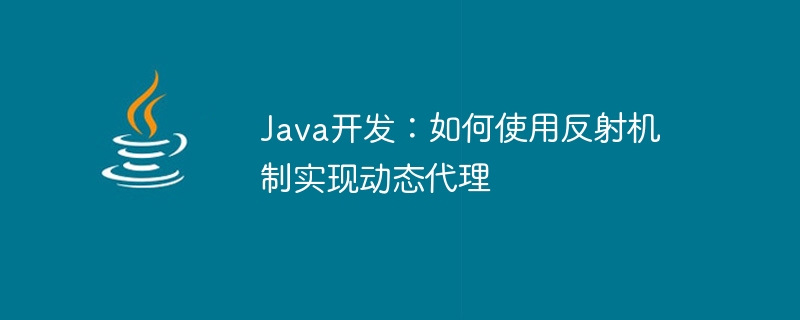Java開發:如何使用反射機制實作動態代理
- 王林原創
- 2023-09-21 08:27:141308瀏覽

Java開發:如何使用反射機制實作動態代理
在Java開發中,反射是一個強大且靈活的特性,可以在運行時動態地載入類、創建物件、呼叫方法等。利用反射機制,我們可以實作動態代理,也就是在程式運行時創建一個實作某個介面的代理類別對象,動態地處理被代理對象的方法呼叫。
為了更好地理解如何使用反射機制實作動態代理,我們先來了解代理模式。代理模式是一種常見的設計模式,它允許透過一個代理物件控制對真實物件的訪問,並在訪問物件之前或之後進行一些額外的操作。在動態代理程式中,代理物件在執行時期生成,並且動態地實作被代理物件的介面。
首先,我們需要定義一個被代理的接口,例如:
public interface UserService {
void saveUser(User user);
User getUserById(int userId);
}然後,我們創建一個實現了該接口的真實業務類,例如:
public class UserServiceImpl implements UserService {
@Override
public void saveUser(User user) {
System.out.println("Saving user: " + user.getName());
}
@Override
public User getUserById(int userId) {
User user = new User(userId, "John Doe");
System.out.println("Getting user: " + user.getName());
return user;
}
}接下來,我們創建一個動態代理類,該類必須實現InvocationHandler接口,例如:
import java.lang.reflect.InvocationHandler;
import java.lang.reflect.Method;
public class UserServiceProxy implements InvocationHandler {
private Object target;
public UserServiceProxy(Object target) {
this.target = target;
}
@Override
public Object invoke(Object proxy, Method method, Object[] args) throws Throwable {
System.out.println("Before calling method: " + method.getName());
Object result = method.invoke(target, args);
System.out.println("After calling method: " + method.getName());
return result;
}
}在動態代理類中,我們使用InvocationHandler接口的invoke方法來處理被代理物件的方法呼叫。在呼叫被代理物件的方法之前,我們可以在控制台輸出一些資訊;在呼叫之後,我們也可以進行一些額外操作。
最後,我們可以使用反射機制建立動態代理物件並呼叫代理物件的方法,例如:
import java.lang.reflect.Proxy;
public class Main {
public static void main(String[] args) {
UserService userService = new UserServiceImpl();
UserServiceProxy proxy = new UserServiceProxy(userService);
UserService userServiceProxy = (UserService) Proxy.newProxyInstance(
userService.getClass().getClassLoader(),
userService.getClass().getInterfaces(),
proxy
);
User user = new User(1, "Alice");
userServiceProxy.saveUser(user);
userServiceProxy.getUserById(1);
}
}在上述範例中,我們首先建立了一個原始的UserService物件及其對應的代理物件UserServiceProxy。然後,我們使用Proxy類別的newProxyInstance方法建立一個動態代理對象,傳入了UserService物件的類別載入器、介面清單和代理對象UserServiceProxy。最後,我們可以透過代理物件呼叫被代理物件的方法,實現動態代理。
運行上述程式碼,我們會在控制台上看到以下輸出:
Before calling method: saveUser Saving user: Alice After calling method: saveUser Before calling method: getUserById Getting user: John Doe After calling method: getUserById
可以看到,在呼叫代理物件的方法時,額外的操作被成功地插入到了被代理對象的方法呼叫前後。
在實際開發中,動態代理常用於AOP(面向切面程式設計)和日誌記錄等面向。它可以在不修改原始業務類別程式碼的情況下,為其增加一些通用的邏輯處理。
總結:透過利用Java的反射機制,我們可以實作動態代理,為原始物件的方法呼叫添加額外操作。上述程式碼範例展示如何定義被代理介面、實作原始業務類別、建立動態代理類別以及呼叫動態代理物件的方法。希望本文能幫助讀者更能理解如何使用反射機制實現動態代理。
以上是Java開發:如何使用反射機制實作動態代理的詳細內容。更多資訊請關注PHP中文網其他相關文章!

